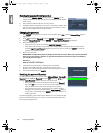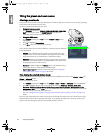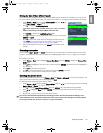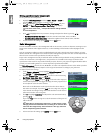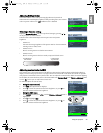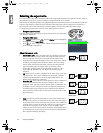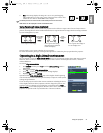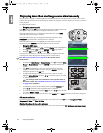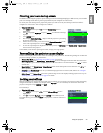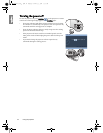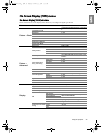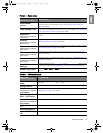
30
Using the projector
English
Selecting the aspect ratio
The "aspect ratio" is the ratio of the image width to the image height. Digital TV is usually in 16:9 ratio, which is
the default for this projector, and most analog TV signals and DVDs are in 4:3 ratio.
With the advent of digital signal processing, digital display devices like this projector can dynamically stretch and
scale the image output to a different aspect than that of the image input source. Images can be stretched in a
linear manner so the whole of the image is stretched equally, or non-linearly, which distorts the image.
To change the projected picture ratio (no matter what aspect the source is):
• Using the remote control
Press one of the aspect ratio buttons to suit the format of the video signal and
your display requirements.
•Using the OSD menu
1. Press MENU and then press / until the Display menu is highlighted.
2. Press to highlight Aspect Ratio.
3. Press / to select an aspect ratio to suit the format of the video signal
and your display requirements.
About the aspect ratio
1. Anamorphic (ANA): Scales an image so that it is displayed in the center
of the screen with a 16:9 aspect ratio. This setting stretches and resizes
linearly, except that it treats the vertical and horizontal dimensions
independently. It stretches the height of the source image until it reaches
the full projected height, and stretches the width of the source image
until it reaches the full projected width. This may alter the projected
aspect, depending upon the original aspect of the source image.
Anamorphic is most suitable for images which are already in a 16:9
aspect, like high definition TV, as it displays them without aspect
alteration.
2. 4:3: Scales a picture so that it is displayed in the center of the screen with
a 4:3 aspect ratio. This is most suitable for 4:3 pictures like computer
monitors, standard definition TV and 4:3 aspect DVD movies, as it
displays them without aspect alteration.
3. Letter Box (LB): Scales a picture to fit the projector’s native resolution in
its horizontal width and resize the picture’s height to the 3/4 of the
projection width. This may produce a picture greater in height than can
be displayed, so part of the picture is lost (not displayed) along the top
and bottom edges of the projection. This is suitable for the display of
movies which are presented in letter box format (with black bars on the
top and bottom).
4. Wide: Stretches the picture horizontally in a non-linear manner, that is,
the edges of the picture are stretched more than the center of the picture
to prevent distortion of the central part of the picture. This is suitable for
occasions where you want to stretch the width of a 4:3 aspect picture to
the width of a 16:9 aspect screen. It does not alter the height. Some
widescreen movies have been produced with their width squashed down
to the width of a 4:3 aspect, and are best viewed when restretched back to
their original width using this setting.
Aspect Ratio
Keystone
Position
Overscan Adjustment
PIP
PC & Component YPbPr Tuning
Display
EXIT Back
0
S-Video
Anamorphic
16:9 picture
4:3 picture
16:9 picture
Letter Box
format picture
4:3 picture
W20000-en.book Page 30 Monday, October 22, 2007 3:35 PM



